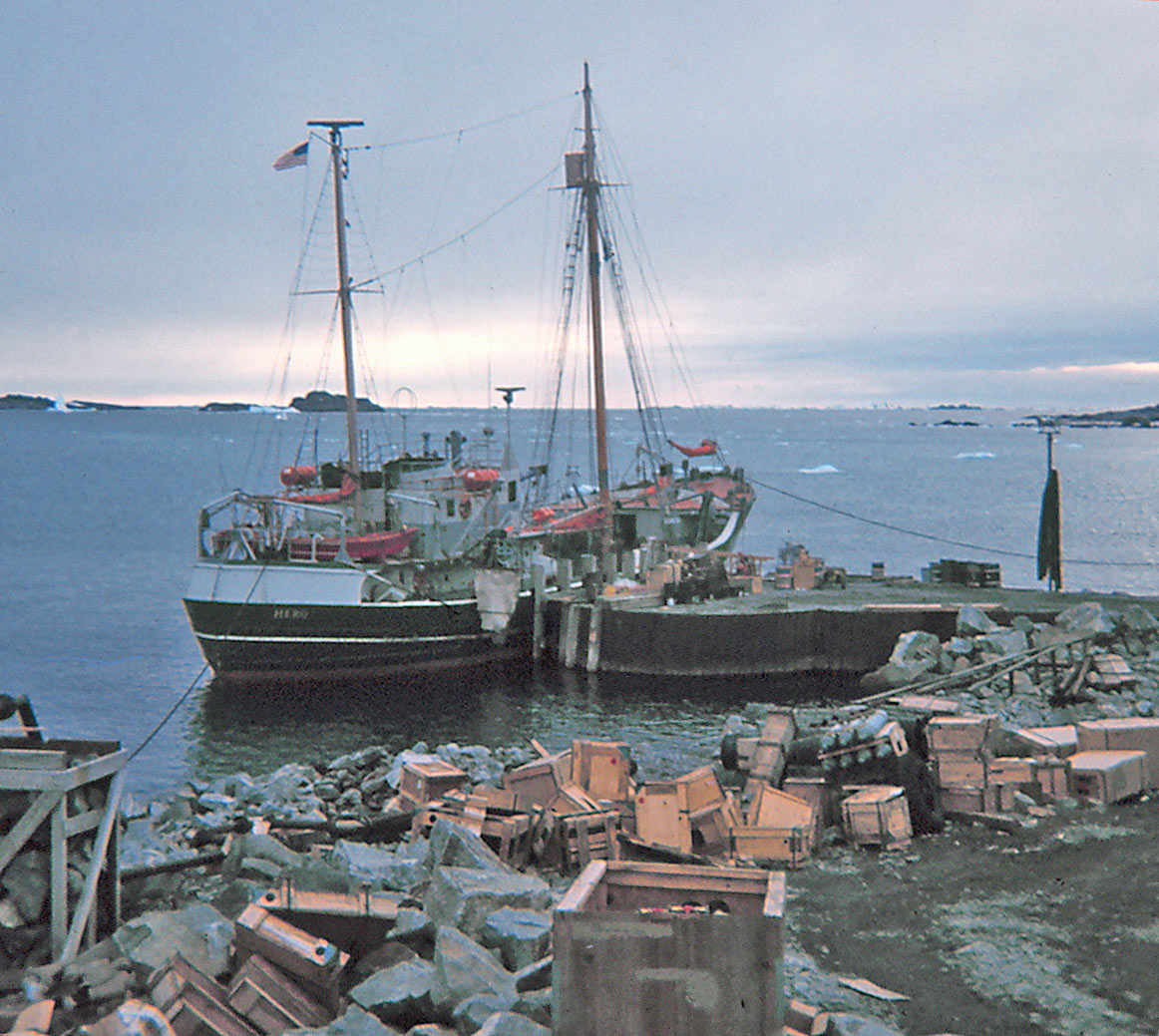For almost 20 years the research vessel Hero lived up to its name, maintaining a lifeline to the National Science Foundation’s Palmer Station base in Antarctica.
Launched in 1968, the 125’x30’4”x12’6” vessel was built by Harvey F. Gamage, Shipbuilder, Inc., South Bristol, Maine, as a heavy duty wooden trawler, with lines similar to the traditional Eastern rig draggers of the northwest Atlantic — but made for ice.

The Hero met impenetrable ice on Dec. 3, 1977 at the entrance to Arthur Harbor on the first trip of the season to Palmer Station. Captain Pieter Lenie views ice conditions for the one-mile
walk to the station. Photo by Miguel L. Brand-Wiener, Antarctic Journal/ via PalmerStation.com.
Framed with 6”x6” ribs set 8” apart, planked with oak and tropical greenheart, the Hero had additional protection from steel sheathing below the waterline. With twin 368-hp diesels, the vessel had to carry scientists and supplies from Chile and Argentina to Antarctica, and navigate waters separating other national science stations at the bottom of the world.
“If you can imagine crossing the Drake Passage in that thing…I remember that very well,” recalled Bill Spindler, an Antarctic historian who worked at the South Pole and at Palmer Station in the 1980s.
Today Spindler maintains a website of Palmer Station history, curating documents and images about the station, built in the mid-1960s on Arthur Harbor at Avers Island. Lately Spindler and other Antarctic alumni have been following sad news: the Hero, after years of failed restoration hopes, sank in early March at a dock in Washington State.
“More than one person who were involved with the boat tried to acquire it,” Spindler said of plans to restore it as a museum and education center of polar exploration. After it was retired in 1984 and sold as surplus, enthusiasts worked toward restoration plans, believing polar exploration should be celebrated as part of American maritime history.
But they could not get enough money, and the boat passed into private ownership, and ultimately, deterioration. It sank on Washington’s Palix River March 4, leaving the Coast Guard and Washington Department of Ecology to deal with leaking diesel fuel and oily waste, and Willapa Bay oyster growers to sweat out the potential impact.
It was a sad end for a boat instrumental in the great U.S. push on Antarctic science in the 1960s and 1970s. The National Science Foundation designed the station and the boat together, naming the endeavor for Nathaniel B. Palmer, the 20-year-old captain of a 30’ sloop named the Hero, part of a seal-hunting expedition from Stonington, Conn., that crossed the Drake Passage in 1820.
Palmer had been dispatched to explore ahead of the other Stonington vessels. Before being forced back by ice, Palmer sighted mountains of the Antarctic Peninsula – earning him historic credit as the first person to lay eyes on the mainland of the southernmost continent.

A design sketch of the Hero. National Science Foundation/ via PalmerStation.com.
In its austere but capable construction, the latter-day Hero harkened back to an earlier age. Equipped with the latest sonar and hydrophone technology for undersea surveys, the boat was also rigged for sail – rarely used, but useful for low-noise surveying and studying wildlife.
“They came up with various design reasons, like sails for quiet operation. I think there was a little bit of romance in that,” Spindler said.
Years after sailing on her, Hero’s old passengers and crew felt the pull. They still checked in on her, and the Palmer Station website has their sad reports of deteriorating conditions. About eight years ago there was renewed talk of trying to save the Hero but “it would have needed a museum with money to take care of it,” Spindler said.
By Friday, responders with Global Diving and Salvage, Seattle, had removed about 1,000 gallons of oily water and absorbent pads, after Washington Ecology workers located a schematic that showed how to access the vessel’s port tanks. With a falling tide, a vacuum truck was brought in to recover the oil.
On Monday, the Coast Guard handed off control of the operation to the state, but may re-enter the case if the Hero’s structure is further compromised. Now, the agencies just have to figure out its ultimate fate.
“It’s posing a lot of risks in that area to our shellfish growers,” said Dave Bennett, a spokesman for Washington Ecology. Spill responders are continuing to remove oil and closely monitor the situation, but a final resolution is not clear yet.
“What that next phase is, I’m not sure,” Bennett said, noting the vessel is now mostly resting on state tidelands administered by the Department of Natural Resources. “There’s a number of directions we’re going in terms of who the responsible parties are.”

Workers with Global Diving and Salvage and Washington State Department of Ecology on the former research vessel Hero. Washington Ecology photo.
Â




